
Databases are at the heart of many applications and are essential for storing and retrieving data. However, despite their importance, databases can be prone to performance issues that can impact application performance. In this post, we cover five of the most common database performance issues and their fixes.
1. A Lack of Indexes
Indexes are a critical component of database performance. An index is essentially a data structure that allows the database to find specific data quickly. When a database has a lack of indexes, it can result in slow queries and poor overall performance.
Suppose we have a database with four tables: tbl_Classroom, tbl_Class, tbl_Student, and tbl_Session. The tbl_Classroom table contains information about each classroom, such as its building name, and room number. The tbl_Class table contains information about each class, such as its class name and allocated teacher. The tbl_Student table contains information about each student, such as their name and student ID. The tbl_Session table contains information about each class session, such as the date, time, and classroom.
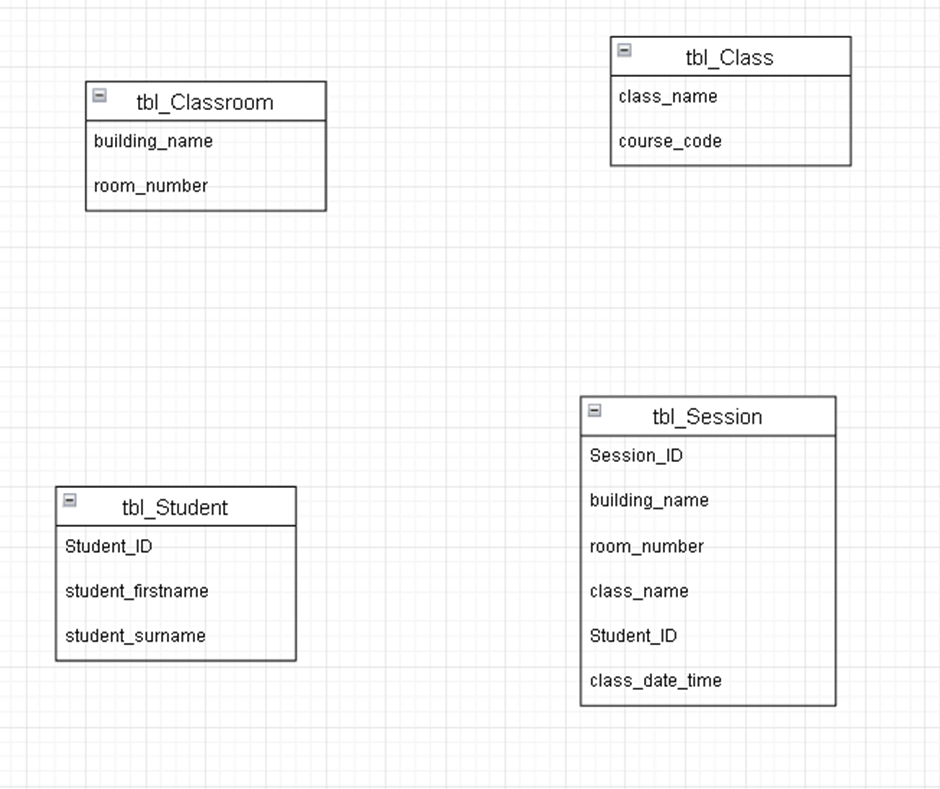
Figure 1 – Non Indexed Database
Without indexing, queries on this database could be slow and inefficient, especially as the size of the database grows. However, by adding appropriate indexes, we can significantly improve query performance.
First, we can add an index to the tbl_Classroom table a Classroom_ID column. This index would allow the database to quickly find a specific classroom by ID, which could be useful for queries such as “find all sessions that took place in the Classroom with the ID of 4”.
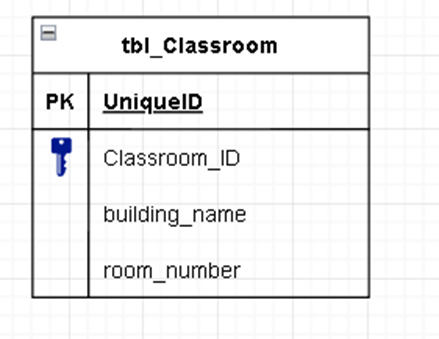
Figure 2 – tbl_Classroom PK added
Next, we can add an index to the tbl_Class table’s Class_ID and course_code columns. This index would allow the database to quickly find a specific class by its ID or course code, which could be useful for queries such as “find all classes using the course_code ABC123.” or “find all classes by Class_ID 17262”
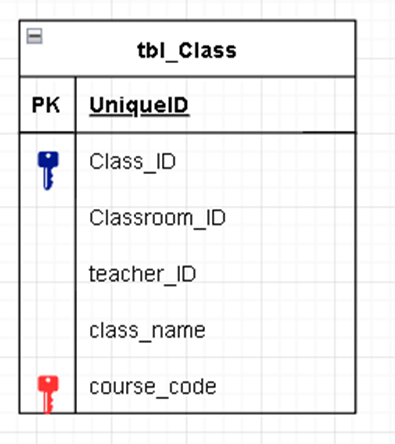
Figure 3 – tbl_Class Keys added
We can also add an index to the student table’s student ID column. This index would allow the database to quickly find a specific student by their ID, which could be useful for queries such as “find the student with the ID 12345.”
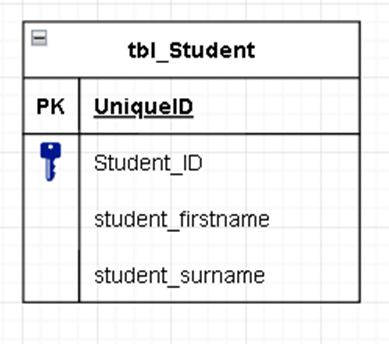
Figure 4 – tbl_Student PK added
Finally, we can add an index to the tbl_Session table’s class ID column. This index would allow the database to quickly find all sessions for a specific class, which could be useful for queries such as “find all sessions for Session_ID 5628.”
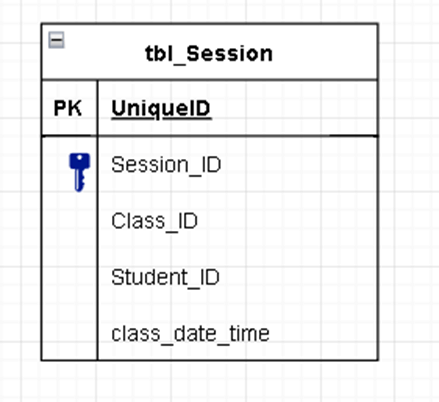
Figure 5 – tbl_Session PK added
By adding these indexes, queries on this database should be much faster and more efficient. The exact performance improvement will depend on the size of the database and the specific queries being executed, but indexing can significantly improve database performance.
The fix for this issue is straightforward: ensure that all tables have appropriate indexes. Start by identifying the most commonly queried columns and create indexes for those columns. Additionally, consider using composite indexes, which are indexes that span multiple columns. The diagram below shows the example Database with indexes and relationships allowing for very fast and efficient database queries to be written and can be used within API queries to provide data access from remote systems.
Using the One-to-Many relationships between the tables we can write efficient queries to pull the relevant data based on the joins between the tables. This allows us to reduce duplicated data (e.g. no need to store the student’s names in the tbl_Session table) which reduces the amount of data that the database needs to store and traverse through during queries.
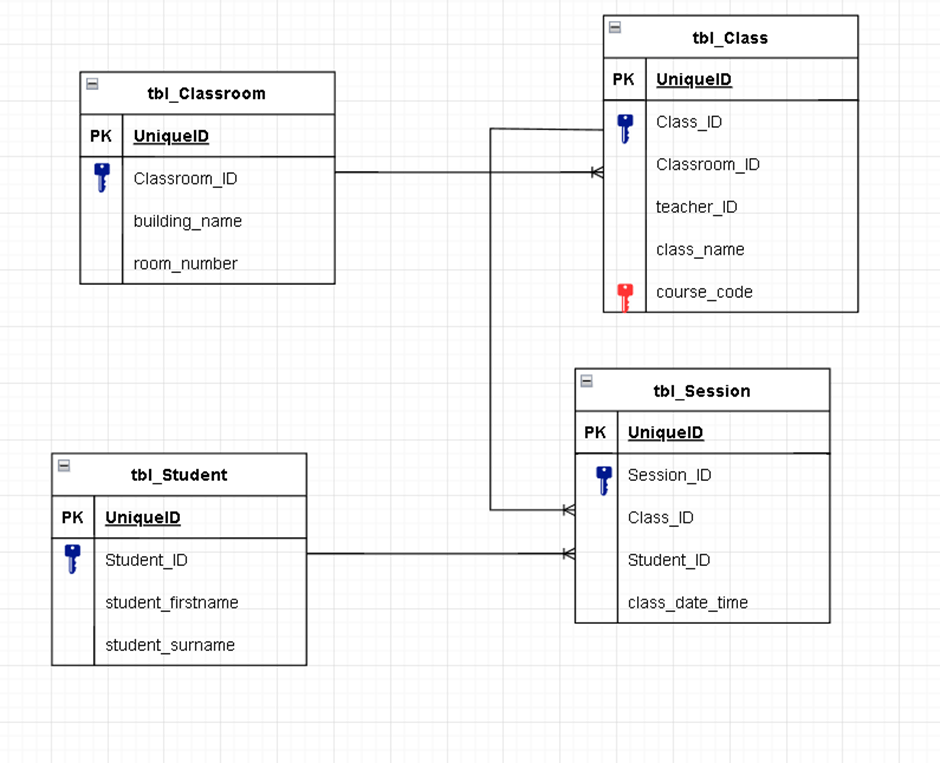
Figure 6 – Indexed Database
2. Inefficient Querying
Inefficient querying is another common database performance issue. Inefficient queries occur when a query requires the database to perform a large amount of work to retrieve data. This can occur when queries are poorly written, retrieve unnecessary data, or are not optimized for the database schema.
One example of an inefficient query using our school database described in our unindexed database above is as follows:-
SELECT * FROM session WHERE class_name LIKE ‘%History%’
The fix for this issue is to ensure that all queries are optimized for the database schema. This can involve rewriting queries to minimize the amount of work required, using appropriate joins, and reducing the amount of data retrieved.
This query retrieves all records from the session table where the class_name column contains the word “History.” However, the use of the ‘%’ wildcard before and after the search term can make this query very slow, especially if the session table is large. The database will need to scan every row in the session table and evaluate the LIKE operator against each row, which can be time-consuming.
A more efficient version of this query would be a more targeted approach using an index. The indexed DB version of the query would be, for example:-
SELECT * FROM session WHERE Class_ID = 123
This query retrieves all records from the session table where the Class_ID column is equal to 123. If the Class_ID column is indexed, this query can be executed much more quickly than the previous query, as the database can quickly locate the relevant rows.
In general, it’s best to avoid using wildcard characters like ‘%’ in SQL queries, as they can lead to slow and inefficient performance. Instead, try to use targeted queries that take advantage of indexes to improve query performance.
3. Improper Data Types
Data types are an essential part of database design. Choosing the wrong data type can result in poor performance and wasted storage space. For example, using a varchar data type for a field that should be an integer can lead to performance issues.
The fix for this issue is to ensure that all data types are appropriate for the data they store. Review the database schema and ensure that each column is using the correct data type. Additionally, consider using data compression to reduce storage requirements.
Determining the appropriate size for a database field can be critical in database design and performance. Here are some best practices for sizing database fields:-
Understand the Data
Before defining a field size, it’s essential to understand the data that will be stored in the field. For example, if you’re designing a field to store names, you should consider how long names can be and if they can contain special characters. Similarly if you’re designing a field to store phone numbers, you should consider if international numbers will be stored.
Use the Smallest Size Possible
When defining field sizes, it’s best to use the smallest size possible that can accommodate the data. For example, if you’re storing a Boolean value, a field size of 1 bit is sufficient. Similarly if you’re storing a short string value, you can use a varchar field with an appropriate size rather than a larger text field.
Allow Room for Growth
While it’s important to use the smallest size possible, you should also leave room for growth in case the data expands. For example, if you’re storing a customer’s email address, you should allow for a field size that can accommodate potential changes in email address formats in the future.
Consider Performance
The size of a database field can impact database performance. Larger fields can take up more storage space and queries that access larger fields can take longer to execute. Therefore, it’s essential to balance field size with performance considerations.
Don’t Rely on Maximum Limits
Most database systems have maximum limits for field sizes, but it’s best not to rely on these limits. Instead, design your fields with a specific purpose , and define an appropriate size based on the stored data.
By following these best practices, you can size database fields appropriately and optimize database performance while allowing room for future growth.
4. Lack of Maintenance
Lack of maintenance is a common issue that can cause significant database performance problems. Regular maintenance activities such as backups, updates, and optimization are essential to ensure that the database runs smoothly and efficiently. Here are the key maintenance activities that are essential for maintaining a healthy database:-
Database Backups
Database backups are one of the most critical maintenance tasks. Backups allow you to restore the database in case of a hardware failure, software corruption, or any other catastrophic event. Without regular backups, you risk losing all your data, which can be disastrous for your business. It’s essential to have a backup schedule that ensures your data is backed up regularly, and the backup is stored in a secure location.
Database Updates
Database updates are essential to ensure that the database software is up to date with the latest patches and bug fixes. Failure to update the database can lead to security vulnerabilities, software bugs, and other issues that can impact the performance of the database. Regular updates can also improve the stability and reliability of the database, ensuring that it runs smoothly and efficiently.
Database Optimization
Database optimization involves fine-tuning the database settings to ensure that it runs efficiently. This includes tasks such as rebuilding indexes, updating statistics, and defragmenting the database. Regular optimization can significantly improve database performance by reducing the time it takes to execute queries and minimizing database downtime.
Monitoring and Performance Tuning
Regular monitoring of the database is essential to identify performance issues early on. By monitoring the database, you can detect issues such as slow query execution, high CPU usage, and disk space issues. Once you identify the problem, you can then take steps to tune the database performance by adjusting the database settings, adding hardware resources, or optimizing queries.
5. Hardware Limitations
Hardware limitations can have a significant impact on database performance. The hardware resources, such as RAM, hard disk space, and CPU, play a critical role in determining how efficiently the database can process data. Let’s take a closer look at some of the common hardware limitations that can impact database performance:-
Insufficient RAM
RAM is a critical component of the database server. It stores frequently accessed data and query execution plans, allowing the database to respond quickly to user requests. If the database server does not have enough RAM, it may resort to using the hard disk as virtual memory, which can significantly slow down database performance. In extreme cases, the database server may even crash due to insufficient memory.
Limited Hard Disk Space
Hard disk space is another critical resource for a database server. Databases require significant amounts of disk space to store data and log files. If the hard disk runs out of space, the database may stop responding, or users may not be able to save data to the database. It’s essential to monitor disk space usage regularly and ensure that there is always sufficient space available.
Inadequate CPU
The CPU plays a critical role in the database server’s performance by processing queries and other database operations. If the CPU is inadequate, it can lead to slow query execution and database performance degradation. In some cases, upgrading the CPU can significantly improve database performance.
Hardware limitations can have a significant impact on database performance. It’s essential to ensure that the database server has sufficient RAM, hard disk space, and CPU to support the workload. Regular monitoring of hardware resources and upgrading them when necessary can help maintain optimal database performance.
How to Fix These Issues and Problems
Improving database performance begins with identifying and addressing slow SQL queries. Thankfully, a variety of tools and techniques can help you pinpoint performance issues and optimize your database for better efficiency.
Most database management systems come with built-in profiling tools that allow you to monitor query performance, analyze execution plans, and track resource utilization. For example, MySQL provides the EXPLAIN statement, which shows how a specific query is executed, helping you identify inefficiencies. Enabling query logging is another effective method. By recording all SQL queries and their execution times, you can analyze this data to pinpoint queries that are taking longer than expected and determine the reasons behind their slowness.
Real-time performance monitoring tools like New Relic and Datadog are invaluable for identifying bottlenecks. These tools continuously track system performance and highlight problematic queries, offering actionable insights to improve database efficiency. Additionally, SQL profilers provide deep insights into query execution plans and performance metrics, helping to uncover optimization opportunities.
For Oracle database users, Automatic Workload Repository (AWR) reports are a powerful resource. These reports capture detailed performance data and help identify resource-intensive SQL statements, making it easier to diagnose and resolve issues.
By leveraging these tools like profiling tools, query logging, performance monitoring tools, SQL profilers, and AWR reports, you can thoroughly analyze query execution plans, performance metrics, and system behavior. This comprehensive approach enables you to optimize your database, ensuring smoother operations, faster query responses, and an overall improved user experience.
Conclusion
Database performance issues can be challenging to diagnose and fix. However, by addressing the most common issues, it is possible to significantly improve database performance. To summarize, ensure that all tables have appropriate indexes, optimize queries for the database schema, choose appropriate data types, use profiling and monitoring tools to identify issues, and optimize API design for database performance.
Consider our LoadView platform to help identify and resolve database and other performance issues for your websites and web applications. Start a free trial today.